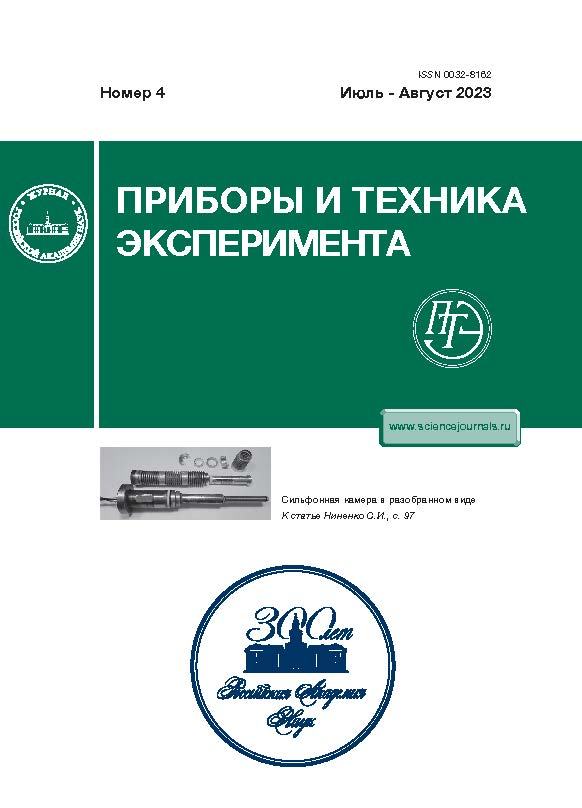Time Resolution and Light Yield of Scintillation Detector Samples for the Time-of-Flight Neutron Detector of the BM@N Experiment
- 作者: Guber F.F.1, Ivashkin A.P.2, Karpushkin N.M.1, Makhnev A.I.1, Morozov S.V.1, Serebryakov D.V.1
-
隶属关系:
- Institute for Nuclear Research, Russian Academy of Sciences
- Institute for Nuclear Research of Russian Academy of Sciences
- 期: 编号 4 (2023)
- 页面: 36-41
- 栏目: ТЕХНИКА ЯДЕРНОГО ЭКСПЕРИМЕНТА
- URL: https://rjraap.com/0032-8162/article/view/670459
- DOI: https://doi.org/10.31857/S0032816223030060
- EDN: https://elibrary.ru/IRMZMA
- ID: 670459
如何引用文章
详细
A new compact time-of-flight neutron detector is being planned for the identification and energy measurement of neutrons produced in nucleus-nucleus interactions at energies up to 4 AGeV at the BM@N experiment, located at the Nuclotron (Joint Institute for Nuclear Research, Dubna, Russia). This detector will be used to measure neutron yields and azimuthal flows, which should be sensitive to the equation of state of dense nuclear matter, as shown in various theoretical models It is proposed to use plastic scintillators produced at JINR and IFTP and silicon photomultipliers with a sensitive area of 6 × 6 mm2 for photon registration, one for each scintillation cell. To achieve the required neutron energy resolution (of the order of several percent) in the energy range up to 4 GeV, the time resolution of scintillation detectors should be 100−150 ps. The concept of a time-of-flight neutron detector is discussed. The results of measurements of the light yield and time resolution of several scintillation detector specimens of various sizes and two types of silicon photomultipliers are presented.
作者简介
F. Guber
Institute for Nuclear Research, Russian Academy of Sciences
Email: karpushkin@inr.ru
108840, Troitsk, Moscow, Russia
A. Ivashkin
Institute for Nuclear Research of Russian Academy of Sciences
Email: vsinev@inr.ru
Moscow, Russia
N. Karpushkin
Institute for Nuclear Research, Russian Academy of Sciences
Email: karpushkin@inr.ru
108840, Troitsk, Moscow, Russia
A. Makhnev
Institute for Nuclear Research, Russian Academy of Sciences
Email: karpushkin@inr.ru
108840, Troitsk, Moscow, Russia
S. Morozov
Institute for Nuclear Research, Russian Academy of Sciences
Email: karpushkin@inr.ru
108840, Troitsk, Moscow, Russia
D. Serebryakov
Institute for Nuclear Research, Russian Academy of Sciences
编辑信件的主要联系方式.
Email: instr@pleiadesonline.com
108840, Moscow, Russia
参考
- Kapishin M. // JPS Conf. Proc. 2020. V. 32. P. 010093. https://doi.org/10.7566/JPSCP.32.010093
- Arsene I., Bravina L., Cassing W., Ivanov Yu., Larionov A., Randrup J., Russkikh V., Toneev V., Zeeb G., Zschiesche D. // Phys. Rev. C. 2007. V. 75. P. 034902. https://doi.org/10.1103/PhysRevC.75.034902
- FOPI Collaboration. Leifels Y. et al. // Phys. Rev. Lett. 1993. V. 71. P. 963. https://doi.org/10.1103/PhysRevLett.71.963
- FOPI Collaboration. Lambrecht D. et al. // Z. Phys. A. 1994. V. 350. P. 115. https://doi.org/10.1007/BF01290679
- Russotto P., Wu P., Zoric M., Chartier M., Leifels Y., Lemmon R., Li Q., Łukasik J., Pagano A., Pawłowski P., Trautmann W. // Phys. Let. B. 2011. V. 697. P. 471. https://doi.org/10.1016/j.physletb.2011.02.033
- LAND collaboration. Blaich T. et al. // Nucl. Instrum. and Methods A. 1992. V. 314. P. 136. https://doi.org/10.1016/0168-9002(92)90507-Z
- R3B collaboration. Boretzky K. et al. // Nucl. Instrum. and Methods A. 2021. V. 1014. P. 165701. https://doi.org/10.1016/j.nima.2021.165701
- Russotto P., Le Fèvre A., Łukasik J., Boretzky K., Cozma M.D., De Filippo E., Gašparić I., Leifels Y., Lihtar I., Pirrone S., Politi G., Trautmann W. // arXiv: 2105.09233 [nucl-ex]. https://doi.org/10.48550/arXiv.2105.09233
- CALICE collaboration. Chadeeva M. et al. // JINST. 2020. V. 15. Iss. 07. C07014. https://doi.org/10.1088/1748-0221/15/07/C07014
- URL https://iftp.ru/
- ALICE Collaboration. Karavicheva T. et al. // J. Phys.: Conf. Ser. 2017. V. 798. P. 012186. https://doi.org/10.1088/1742-6596/798/1/012186












